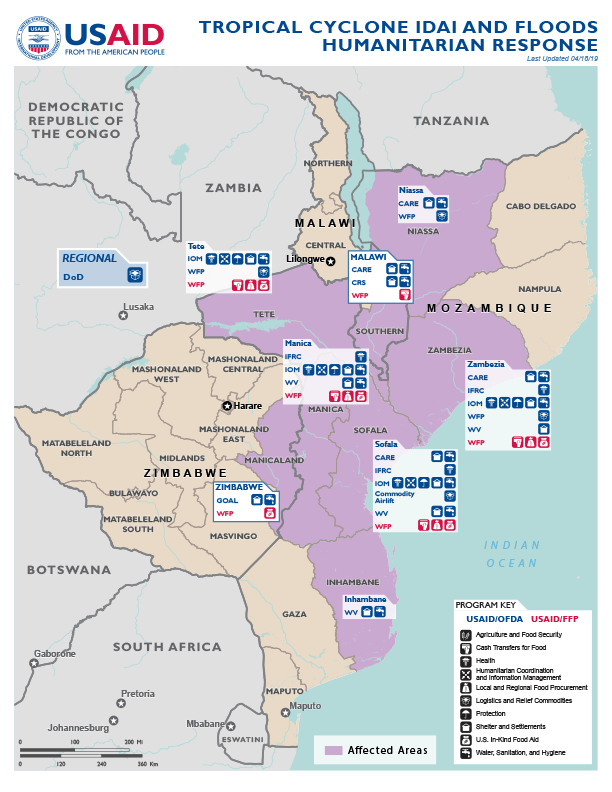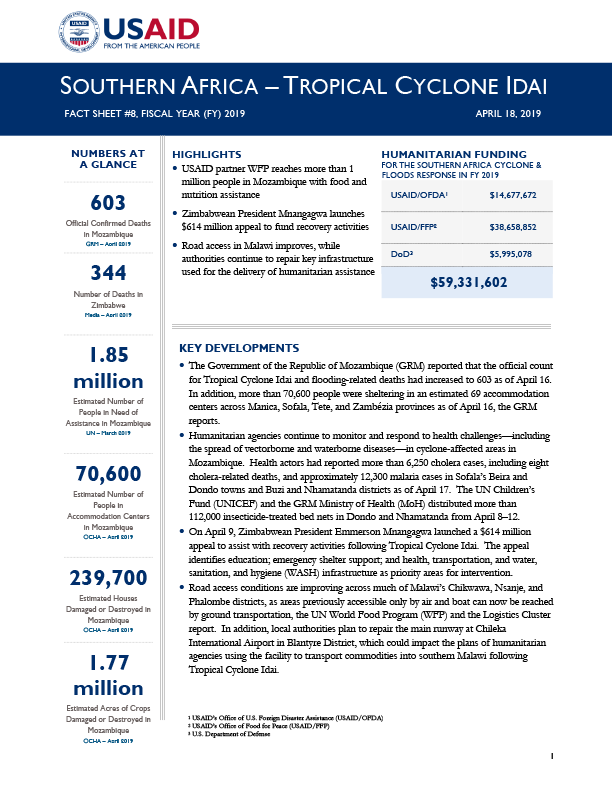Speeches Shim
April 18, 2019
Numbers At A Glance
603
344
1.85 million
70,600
239,700
1.77 million
Humanitarian Funding
FOR THE SOUTHERN AFRICA CYCLONE & FLOODS RESPONSE IN FY 2019
| USAID/OFDA | $14,677,672 |
| USAID/FFP | $38,658,852 |
| DoD | $5,995,078 |
| TOTAL | $59,331,602 |
Highlights
- USAID partner WFP reaches more than 1 million people in Mozambique with food and nutrition assistance.
- Zimbabwean President Mnangagwa launches $614 million appeal to fund recovery activities.
- Road access in Malawi improves, while authorities continue to repair key infrastructure used for the delivery of humanitarian assistance.
Key Developments
The Government of the Republic of Mozambique (GRM) reported that the official count for Tropical Cyclone Idai and flooding-related deaths had increased to 603 as of April 16. In addition, more than 70,600 people were sheltering in an estimated 69 accommodation centers across Manica, Sofala, Tete, and Zambézia provinces as of April 16, the GRM reports.
Humanitarian agencies continue to monitor and respond to health challenges—including the spread of vectorborne and waterborne diseases—in cyclone-affected areas in Mozambique. Health actors had reported more than 6,250 cholera cases, including eight cholera-related deaths, and approximately 12,300 malaria cases in Sofala’s Beira and Dondo towns and Buzi and Nhamatanda districts as of April 17. The UN Children’s Fund (UNICEF) and the GRM Ministry of Health (MoH) distributed more than 112,000 insecticide-treated bed nets in Dondo and Nhamatanda from April 8–12.
On April 9, Zimbabwean President Emmerson Mnangagwa launched a $614 million appeal to assist with recovery activities following Tropical Cyclone Idai. The appeal identifies education; emergency shelter support; and health, transportation, and water, sanitation, and hygiene (WASH) infrastructure as priority areas for intervention.
Road access conditions are improving across much of Malawi’s Chikwawa, Nsanje, and Phalombe districts, as areas previously accessible only by air and boat can now be reached by ground transportation, the UN World Food Program (WFP) and the Logistics Cluster report. In addition, local authorities plan to repair the main runway at Chileka International Airport in Blantyre District, which could impact the plans of humanitarian agencies using the facility to transport commodities into southern Malawi following Tropical Cyclone Idai.
MOZAMBIQUE
Humanitarian Response and Gaps
As of April 17, the GRM reported more than 6,250 cholera cases in Beira, Buzi, Dondo, and Nhamantada. Nearly 99 percent of cases were treated with outpatient services, indicating primarily mild and moderate cases. The daily number of new cases continues to decline, and U.S. Centers for Disease Control and Prevention staff expect cholera transmission to continue decreasing in the coming weeks. To prevent further spread of the disease, UNICEF supported approximately 900 community members to provide messaging on preventative WASH-related behaviors to an estimated 30,000 households in Beira from April 8–12.
Health agencies recorded approximately 12,300 malaria cases as of April 17, although relief organizations note that the actual number of malaria cases is likely higher due to underreporting. Many of the reported cases are in rural areas where access to health care services is often limited. From April 8–12, UNICEF supported the GRM MoH to distribute more than 112,000 insecticide-treated bed nets in Dondo and Nhamatanda to address the elevated number of malaria cases.
The UN Office for the Coordination of Humanitarian Affairs (OCHA) has been integrating prevention of sexual exploitation and abuse (PSEA) training into the Tropical Cyclone Idai response and recently established referral pathways and service provision guidelines for survivors of sexual exploitation and abuse. The UN agency also created and distributed materials with PSEA messaging to partners operating in cyclone-affected communities. In response to reports of sexual exploitation and abuse incidents in Nhamatanda, an OCHA-led PSEA task force team deployed to follow up and refer the cases for further investigation. The early detection and investigation of the incidents signify that PSEA reporting and referral processes are functioning well.
Following reports of households not receiving assistance, OCHA representatives are working to identify hard-to-reach areas and deliver emergency relief supplies to isolated populations. After verifying an area’s location, OCHA staff coordinate with humanitarian agencies from the nearest hub as well as the GRM National Disasters Management Institute, utilizing air assets where necessary to deliver supplies.
USG Response and Assessments
USAID partner WFP had provided emergency food assistance to more than 1 million people affected by Tropical Cyclone Idai in Mozambique as of April 16. The UN agency provided cyclone- and flood-affected populations with 30-day rations of rice and maize meal, pulses, fortified blended food and vegetable oil. Where local markets are functioning, WFP is transitioning from general food distributions to cash-based transfers. In coordination with the GRM, the UN agency plans to reach up to 1.7 million people with food and nutrition assistance in Manica, Sofala, Tete, and Zambézia.
ZIMBABWE
Current Situation
On April 9, Zimbabwean President Mnangagwa launched a $614 million appeal to support recovery activities in the country following Tropical Cyclone Idai. The appeal identified education, emergency shelter support, health infrastructure, transportation infrastructure, and WASH as priority areas for intervention.
On April 16, the Government of Zimbabwe MoH launched a preventative two-dose cholera vaccination campaign aiming to inoculate nearly 488,000 people in Chimanimani and Chipinge districts. Tropical Cyclone Idai caused flooding that damaged water distribution and sanitation infrastructure in the districts, increasing the risk of infection by waterborne diseases—including cholera—among local populations; however, health actors had not recorded cholera cases in cyclone-affected areas of Zimbabwe as of April 16.
MALAWI
Current Situation
Access conditions were improving across much of Chikwawa, Nsanje, and Phalombe as of April 14, according to WFP and the Logistics Cluster—the inter-agency coordinating body for operations and information management, comprising UN agencies, non-governmental organizations, and other stakeholders. Areas in Nsanje and Phalombe previously accessible only by air and boat can now be reached by light trucks as water levels recede and road rehabilitation activities continue; however, Chikwawa’s Mazongosa village and Nsanje’s Chigwafumu, Chikali, and Makhanga villages remained inaccessible by road as of April 17.
Local authorities plan to repair the main runway at Chileka International Airport in Blantyre District from April 24–July 23 to bring it into compliance with international safety standards. Humanitarian actors are using the airport as a logistics hub for response activities in southern Malawi following Tropical Cyclone Idai. A smaller runway at the facility will remain operational through the repair period for organizations planning deliveries of relief commodities to the region; however, the airport’s decreased capacity could restrict the size and frequency of humanitarian flights into Chileka.
On April 12, the Government of Rwanda provided $200,000 in disaster relief funding to the Government of Malawi. The contribution follows an in-kind donation of food and relief commodities—including maize flour, kitchen supplies, clothing, and medical supplies—valued at $550,000 from the Government of Zambia to the GoM on April 11.
CONTEXT
Tropical Cyclone Idai made landfall over Mozambique’s city of Beira, Sofala Province, on March 15, producing torrential rains and strong winds and severely affecting Manica, Sofala, Tete, and Zambézia provinces. The cyclone also caused significant flooding, damage and destruction of property and infrastructure, and resulted in numerous deaths in southern Malawi’s Chichawa, Nsanje, Phalombe, and Zomba districts and Zimbabwe’s Manicaland Province. The same weather system had previously brought heavy rains that caused significant flooding in Malawi and Mozambique in early March, before gaining strength in the Mozambique Channel and evolving into a tropical cyclone.
On March 10, U.S. Ambassador to Malawi Virginia E. Palmer declared a disaster due to the effects of floods in Malawi. In response USAID/OFDA provided an initial $200,000 to CARE and Catholic Relief Services. On March 15, U.S. Ambassador to Mozambique Dennis W. Hearne declared a disaster due to the effects of floods in Mozambique. Ambassador Hearne declared a second disaster on March 19 due to the impact of Tropical Cyclone Idai in Mozambique. In response, USAID/OFDA provided $200,000 to CARE to procure emergency relief commodities and support shelter and WASH interventions. USAID/OFDA also provided $200,000 to World Vision to response to immediate WASH and shelter needs. On March 18, U.S. Ambassador to Zimbabwe Brian A. Nichols declared a disaster due to the impact of Tropical Cyclone Idai. In response USAID/OFDA provided an initial $100,000 to GOAL to procure emergency relief commodities and support shelter and water, sanitation, and hygiene interventions.
On March 20, USAID deployed a DART to lead the USG response to Tropical Cyclone Idai in Mozambique. USAID also activated a Washington, D.C.-based Response Management Team (RMT) to support the DART. The DART and RMT are responding to the situation in coordination with other USG counterparts, GoM representatives, and humanitarian partners.
PUBLIC DONATION INFORMATION
The most effective way people can assist relief efforts is by making cash contributions to humanitarian organizations that are conducting relief operations. A list of humanitarian organizations that are accepting cash donations for disaster responses around the world can be found at www.interaction.org.
USAID encourages cash donations because they allow aid professionals to procure the exact items needed (often in the affected region); reduce the burden on scarce resources (such as transportation routes, staff time, and warehouse space); can be transferred very quickly and without transportation costs; support the economy of the disaster-stricken region; and ensure culturally, dietarily, and environmentally appropriate assistance.
More information can be found at:
- USAID Center for International Disaster Information: www.cidi.org or +1.202.661.7710.
- Information on relief activities of the humanitarian community can be found at www.reliefweb.int.



Comment
Make a general inquiry or suggest an improvement.